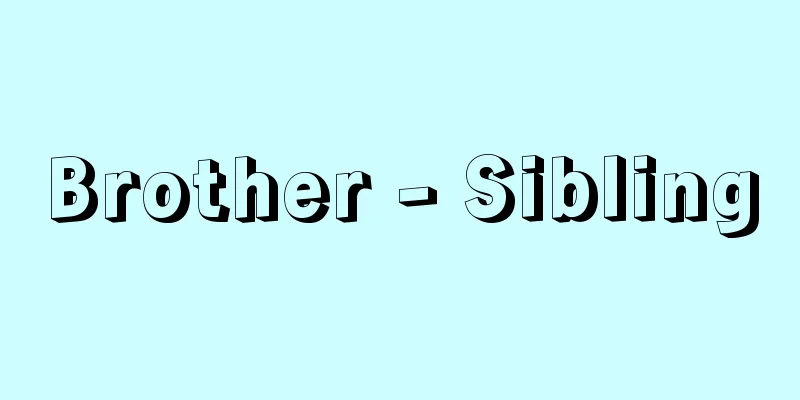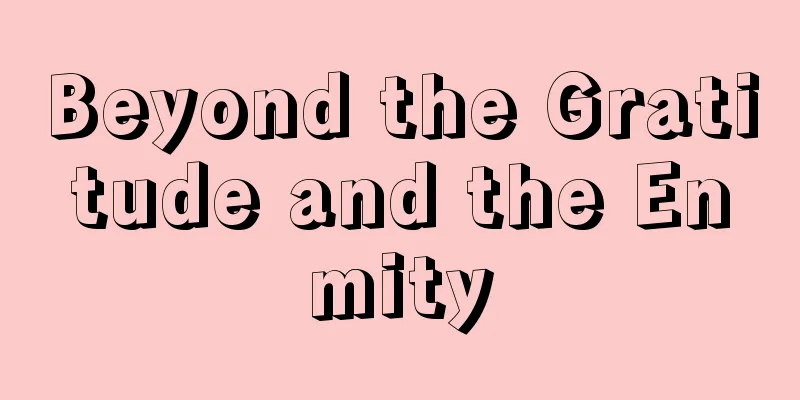Kamishibai - Picture storytelling

|
A type of performing art. It is also used as an audiovisual educational material. Kamishibai evolved from the moving magic lanterns called utsushie, which were performed from the end of the Edo period to the mid-Meiji period. Some say that the origin of kamishibai can be found in Buddhist picture explanations and peep tricks, but these are merely guesses due to the similarity of form. In the mid-Meiji period, a single performer performed at a variety hall using flat paper dolls pasted on both sides. The performers called it utsushie, but the audience called it kamishibai because it was a play using paper dolls. At the end of the Meiji period, it came into the hands of a target performer, and during the Taisho period, it was performed at festivals and fairs for children in a tented hut about the size of three tatami mats, charging an admission fee. The main acts were kabuki-style ghost stories and chivalrous stories, or "Journey to the West: Son Goku" (Son Goku). These early paper puppet plays later came to be called tachie, and each performer would speak the lines while operating up to four puppets, the largest of which was about 15 centimetres tall, and musical instruments such as clappers, drums, bells and gongs. In 1929 (Showa 4), about 40 Tokyo stand-up picture storytellers returned the cups to the target-ya boss and formed the Tokyo Picture Storytellers Union. They began to perform kamishibai (picture storytelling shows) in streets and vacant lots where target-ya had no territories, selling candy in lieu of admission fees. The number of kamishibai storytellers gradually increased as unemployment increased due to the Great Depression at the time. From around 1931, kamishibai became more of a freebie when unemployed people sold candy to children, rather than a form of street performance. In 1931, a kamishibai performer who toured around Kikuyabashi in Asakusa, Tokyo, was banned by the police from showing kamishibai because it was "not good for children." So the performer came up with a picture story kamishibai that was not prohibited by the police. This new style, in which several pictures are placed in a frame and the story is explained while showing each picture one by one, is called hirae (flat picture) as opposed to tate-e (standing picture). With the influx of unemployed people into the kamishibai business, the number of kamishibai performers increased nationwide, and the production and explanation of kamishibai became established as a profession. At the same time, the size of the kamishibai screen, which was originally about 10 cm high and 14 cm wide, became the standard about 18 cm high and 25 cm wide after a few years. The first popular flat picture kamishibai program was the science fiction adventure "Golden Bat," influenced by Jules Verne and Oshikawa Shunro. Compared to the old-fashioned stories, the stories were fresh and well-received, and within a few months, Hirae overtook Tate-e, and Hirae became synonymous with Kamishibai. Later, manga and fairy tales were also made into Kamishibai. Hirae Kamishibai were hand-painted and only a few copies were made, which were then lent out in turn and circulated around the country. In 1935, there were about 2,500 Kamishibai producers in Tokyo and 30,000 nationwide. At the end of 1937, most of the Kamishibai producers and lenders in Tokyo joined forces to form a joint-stock company, and were eventually incorporated into the wartime cultural control. Separately, educators who criticized street Kamishibai as being uneducational began producing printed Kamishibai in 1937, and called them educational Kamishibai, which helped with national wartime propaganda. Since then, there have been two types of Kamishibai: hand-painted street Kamishibai and printed Kamishibai. Many of the kamishibai were destroyed in air raids at the end of World War II, and the remaining works were confiscated and burned by the occupying forces after Japan's defeat, on the grounds that they promoted militarism during the period of military rule. At the end of 1945, several artists who had been engaged in drawing kamishibai during the war gathered at the home of Kata Koji in Higashikanamachi, Katsushika Ward, Tokyo, and started the business of producing and renting out kamishibai. After that, kamishibai developed rapidly, taking advantage of the benefits of selling food illegally and earning cash in an era of food shortages and inflation. In 1948, there were 3,000 kamishibai presenters in Tokyo and 50,000 presenters nationwide. "Golden Bat" became popular again, and various imitations were born not only in kamishibai but also in children's magazines and radio stories. Around 1950, the development of kamishibai halted with the revival of confectionery manufacturers, the spread of various entertainment for children, and the establishment of kindergartens, nursery schools, and elementary schools. Around 1958, kamishibai rapidly declined as a result of the spread of television, and after 1960, it was almost extinct. Among those who created kamishibai, the young artists switched to creating rental comics and gekiga, and the techniques of kamishibai were later passed down to story comics and gekiga, etc. Printed kamishibai were also valued as audiovisual educational materials in the new postwar education system, and were created for loan to kindergartens, nursery schools, elementary schools, children's groups, and libraries, continuing to be made even after the decline of street kamishibai. [Kada Koji] "Minami Hiroshi et al., eds., Art Book 8: Etoku (The World of Kamishibai, Peep Shows, and Imitation Pictures)" (1982, Hakusuisha) [Reference] |Source: Shogakukan Encyclopedia Nipponica About Encyclopedia Nipponica Information | Legend |
|
演芸の一種。視聴覚教育材としても使われる。紙芝居は江戸時代の末ごろから明治中期にかけて興行された写し絵という動く幻灯から転化したものである。紙芝居の原型を、仏教の絵解きやのぞきからくりに求める説もあるが、それらは形態が似ているゆえの当て推量にすぎない。明治中期に扁平な紙人形を裏表に貼(は)り合わせたものを用いて、1人の演者が寄席(よせ)で演じた。演じる側は写し絵という名称を使ったが、観客は紙人形の芝居であるから紙芝居とよんだ。明治末に的屋(てきや)の手に渡って、大正年間には祭礼、縁日などで天幕張りの畳3枚ほどの広さの小屋で子供相手に入場料をとって演じた。おもな出し物は歌舞伎(かぶき)種の怪談物や侠客(きょうかく)物、あるいは『西遊記・孫悟空(そんごくう)』であった。のちにこの初期の紙人形の芝居を立絵(たちえ)とよぶが、演者は、立絵の最大のもので高さ15センチメートルぐらいの人形4枚までと、拍子木、太鼓、鉦(かね)、銅鑼(どら)などの鳴物を1人で操作しながら、台詞(せりふ)をしゃべって演じた。 1929年(昭和4)東京の立絵説明者約40人は的屋の親分に杯(さかずき)を返して、東京写絵業者組合を結成して、的屋の縄張りのない街路、空き地などで、入場料のかわりに飴(あめ)を売って紙芝居を見せるようになった。紙芝居業者は当時の世界経済恐慌による失業者の増加でしだいに増えた。1931年ごろからは、紙芝居は大道芸というよりは、失業者が子供相手にする飴売り行商のおまけになった。 1931年、東京・浅草菊屋橋あたりを回っていた紙芝居屋が、警察から「子供のためにならぬ」という理由で紙芝居を見せることを禁じられた。そこで紙芝居屋は警察の禁止外の絵物語の紙芝居を考案。この、何枚かの絵を枠に入れて順次1枚ずつ見せながら物語を説明するという新しい形式を、立絵に対して平絵(ひらえ)とよぶ。失業者群の紙芝居業への流入によって全国的に紙芝居業者が増えて、紙芝居の製作と説明は職業として定着した。それとともに、初めは高さ10センチメートル、横14センチメートルほどの画面であった紙芝居の大きさも、2、3年後には高さ18センチメートル、横25センチメートルほどを標準とするようになった。平絵の紙芝居の最初の人気番組はジュール・ベルヌと押川春浪(おしかわしゅんろう)の影響による空想科学冒険物『黄金バット』であった。従来の旧式な物語に比べると新鮮であったので大好評を博し、数か月で平絵は立絵を圧倒し、紙芝居といえば平絵と思われるようになり、のちに漫画や童話なども紙芝居化された。平絵紙芝居は肉筆で一部だけしかつくられず、それを順番に貸して全国に回した。1935年には紙芝居業者は東京で2500人ほど、全国では3万人に及んだ。1937年末、東京の紙芝居製作貸出し業者の大部分が連合して株式会社をおこし、やがて戦時文化統制に組み込まれた。これとは別に、街頭紙芝居を非教育的であると批判した教育関係者が1937年に印刷紙芝居の製作を始め、教育紙芝居と称して戦争のための国策宣伝に協力した。以後、肉筆の街頭紙芝居と印刷紙芝居の2種が存在する。第二次世界大戦末期の空襲で紙芝居の多くは焼失し、残った作品も敗戦後、軍政下の時期に軍国主義の宣伝をしたという理由で駐留軍により没収され、焼却された。 1945年(昭和20)末、戦争中に紙芝居の作画に従事していた数名の作画家が、東京の葛飾(かつしか)区東金町(ひがしかなまち)の加太こうじ宅に集まって紙芝居の製作と貸出しの仕事を始めた。以後、紙芝居は、食糧難とインフレの時代における闇(やみ)食品販売と現金収入の利点をもって急速に発展した。1948年には東京で3000人、全国では5万人の説明者がいた。『黄金バット』はまた流行し、さまざまな亜流を、紙芝居だけではなく児童雑誌、ラジオなどの物語にも発生させた。1950年ごろから菓子製造メーカーの復活、各種児童向き娯楽の普及、幼稚園・保育園・小学校の整備に伴って紙芝居の発展は止まり、1958年ごろからはテレビの普及などの結果、急速に衰退し、1960年以後は消滅に近い状態になった。 紙芝居をつくっていた人たちのうち、若手の画家は貸本用漫画や劇画に転じたため、のちに紙芝居の技法はストーリー漫画や劇画などに伝承された。また印刷紙芝居は、戦後の新しい教育のなかで視聴覚教育材として重視され、幼稚園・保育園・小学校・子供会・図書館での貸出し用などとしてつくられ、街頭紙芝居の衰退後も続いている。 [加太こうじ] 『南博他編『芸双書8 えとく(紙芝居・のぞきからくり・写し絵の世界)』(1982・白水社)』 [参照項目] |出典 小学館 日本大百科全書(ニッポニカ)日本大百科全書(ニッポニカ)について 情報 | 凡例 |
<<: Kamishihi [village] - Kamishihi
Recommend
Means of harming the enemy
It refers to combat actions taken by a belligerent...
Prairie Pointer
...It is native to North America and has about 30...
Chymosin
Rennin is used in the coagulation of milk during ...
Porifera
…the name of the invertebrate organisms belonging...
Urushigusa (Desmarestia ligulata)
A brown alga in the family Phanerocarpus. It is fl...
Empson, William
Born: September 27, 1906, Yorkfleet, Yorkshire [Di...
manual flow line
…Generally, in mass production where a specific v...
Telecommunications - denkitsuushin (English)
This generally refers to any means of communicati...
Kakokai - Kakokai
One of the nationalistic revolutionary groups tha...
Lewis W. Hine
American photographer. Born in Oshkosh, Wisconsin...
Yoshitoshi Tsukioka
An ukiyo-e artist from the late Edo to the Meiji ...
Bath additives - Yokuyozai
These are non-medicinal products and medicines use...
Fakhr al-Din II
1572‐1635 Amir (governor) of the Ma'n family, ...
Academic books - gakujutsusho
… [Planning and editing] Publishers have their ow...
motor grader
…It is said that the first grader was used in the...









